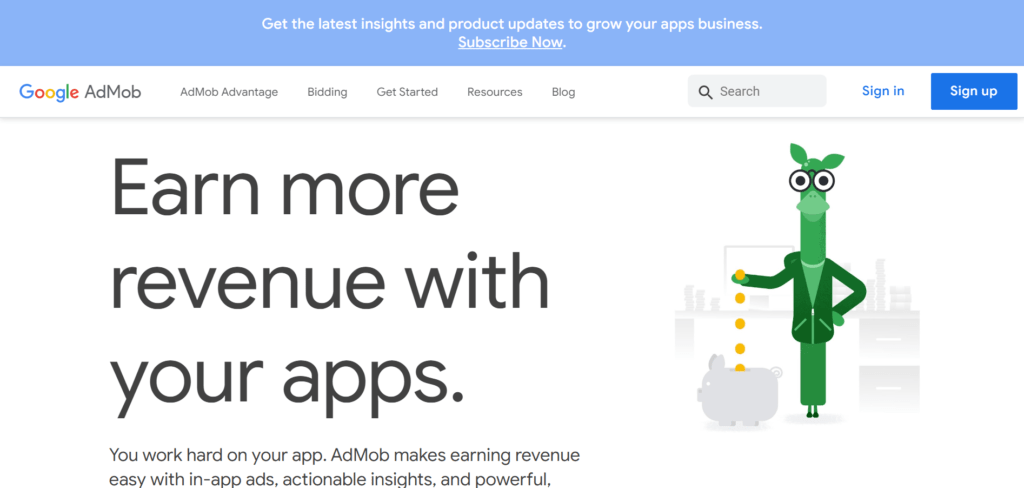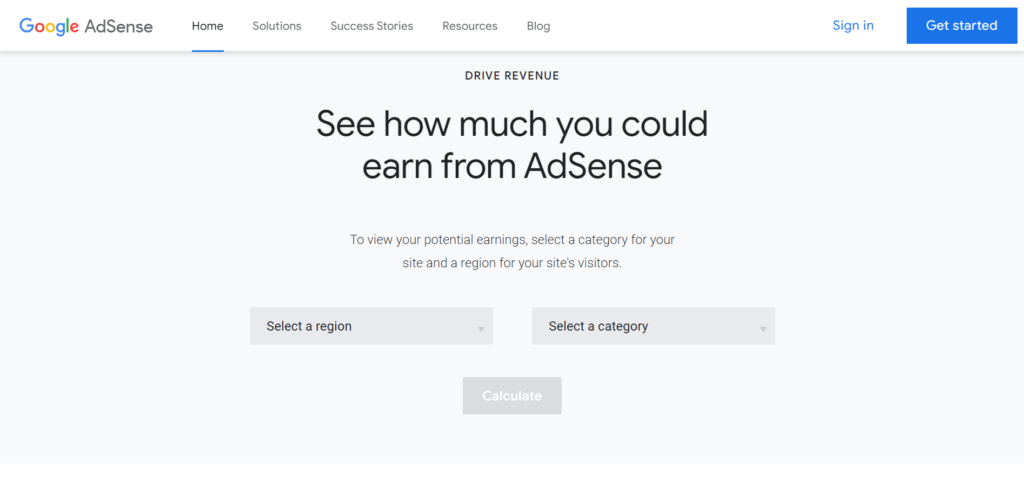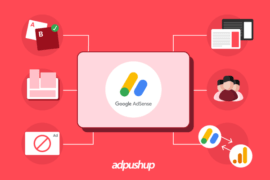Comparing Admob and Adsense, both are used to generate revenue with Google, but there are few differences between these two platforms. Let’s start with AdMob vs AdSense.
If you’re a publisher or an app developer, you know how critical it is to maximize revenue streams. With so many different ad platforms available today, it can take time to know which is best for your specific needs. That’s why we’re here to talk about the big guns: AdMob and AdSense.
- AdSense is the program that allows publishers to serve text, images, videos, or interactive media advertisements on Google. There are over 58,658,380+ Google Adsense users globally.
- AdMob is a Google-owned ad network that allows publishers to monetize their mobile apps with relevant ads from a huge inventory of advertisers. Approx. 1 million + Google advertisers are on AdMob.
These two behemoths are the top players in the mobile ad space, each with unique strengths and weaknesses.
So, buckle up and get ready to dive deep into the world of mobile advertising.
To start, let’s take a closer look at what AdMob and AdSense are and how they work.
Also Read: Looking for AdSense vs. AdWords? Here’s Your Complete Guide
AdMob vs AdSense: A Detailed Overview
Alright, people, let’s get down to brass tacks. First up, AdMob. Developed by Google, it is a mobile ad platform. It allows monetization of apps created by app developers.

AdMob supports various ad formats, including banner ads, interstitials, and rewarded video ads, and it offers powerful targeting options that help you reach the right audience at the right time.
AdMob Estimated Revenue for Each Ad Unit:
Earnings Reported by Ad Network / Total Number of Impression for All Ad Units * Number of Impressions for Ad Unit.
Undoubtedly, Video game advertising on mobile is the easiest way for publishers to monetize, and advertisers have the opportunity to show ads to their target audiences.
Platforms such as Meta and Google AdMob offer video gaming ads in the following different formats:
- Interstitial
- Native Banners
- Contextual
- Rewarded
- Expandable
- In-game
AdMob also has a featured called – “smart banners” that automatically adjusts the banner ad size to different devices. (Source: SEJ)
Moving on to AdSense. Developed by Google, AdSense is a web-based ad platform that allows publishers to monetize their websites and blogs by displaying ads to their visitors.

AdSense offers a wide variety of ad formats, including display ads, text ads, and link units, and it allows you to customize the look and feel of your ads to match your site’s branding.
Check: AdSense Calculator: Estimate Your Potential Earnings in (2023)
So, AdMob is all about mobile apps, while AdSense is all about websites and blogs. But what about the specifics?
Let’s take a closer look at the key features of each platform.
AdMob Features
- Ad Formats: AdMob supports various ad formats, including banner ads, interstitials, and rewarded video ads. You can choose the best design for your app and users.
- Targeting Options: AdMob offers a range of powerful targeting options, such as location targeting, demographic targeting, and contextual targeting. These options allow you to reach the right audience and maximize your revenue potential.
- Integration With Other Google Products: AdMob integrates with other Google products, such as Google Analytics, Firebase, and Google Ads, which allows you to access powerful tools for tracking your app’s performance and optimizing your ad revenue.
AdSense Features
- Ad Formats: AdSense offers a wide variety of ad formats, including display ads, text ads, and link units. You can choose the best design for your site and audience.
- Customization Options: AdSense allows you to customize the look and feel of your ads to match your site’s branding. You can choose the ad colors, fonts, and sizes that work best for you.
- Performance Reporting: AdSense provides detailed performance reports that allow you to track your ad revenue, see which ads are performing best, and optimize your ad placement for maximum gain.
AdMob and AdSense are both powerful ad platforms with unique features and strengths. But which one is right for you? That’s what we’ll tackle next. Stay tuned!
Also Read: AdSense vs AdPushup Comparison
AdMob vs AdSense – Differences Explained
Now that we’ve covered the basics of AdMob and AdSense, it’s time to dive into the key differences between these two ad platforms. Here are the main areas where these platforms differ:
Ad Formats
As we discussed earlier, AdMob is focused on mobile apps and supports banner ads, interstitials, and rewarded video ads. On the other hand, AdSense focuses on websites and supports display ads, text ads, and link units.
Targeting Options
AdMob and AdSense offer powerful targeting options but differ in their approach. AdMob offers more granular targeting options, such as location targeting, demographic targeting, and contextual targeting. On the other hand, AdSense focuses more on interest-based targeting, which means that it shows ads to users based on their browsing history and interests.
Payment Models
AdMob and AdSense also differ in their payment models. AdMob operates on a cost-per-click (CPC) or cost-per-thousand-impressions (CPM) basis, which means that you earn money when users click on your ads or when your ads are displayed to users. AdSense, on the other hand, operates on a revenue share basis, which means that you earn a percentage of the revenue generated by the ads displayed on your site.
Audience
AdMob focuses on reaching mobile app users, while AdSense focuses on getting website visitors. Depending on your audience and the type of content you produce, one platform may be a better fit for you than the other.
Integration
As we mentioned earlier, AdMob integrates with other Google products, such as Google Analytics, Firebase, and Google Ads.
AdSense, on the other hand, is more standalone. AdMob and AdSense are great platforms for monetizing your content, but they have different strengths and weaknesses depending on your goals and target audience. The next step is to decide which platform is right for you.
AdMob vs AdSense – Pros & Cons
Both AdMob and AdSense have their strengths and weaknesses. Let’s take a closer look at the advantages and disadvantages of each platform.
Pros of AdMob
- High Revenue Potential: AdMob has the potential to generate increased revenue, particularly if you have a large user base and can show a high volume of ads.
- Targeted Advertising: AdMob offers more granular targeting options, which means you can show your ads to users who are more likely to engage with them.
- Easy to Use: AdMob is relatively easy to set up and use, particularly if you’re already familiar with other Google products.
- Seamless Integration: AdMob integrates with other Google products, such as Google Analytics, Firebase, and Google Ads, which can provide you with additional insights and advertising opportunities.
Cons of AdMob
- Focused on Mobile Apps: AdMob is only designed for mobile apps, so if you have a website, you’ll need to use a different platform.
- Limited Ad Formats: AdMob only offers a limited number of ad formats, which may not be suitable for all types of content.
- Limited Revenue Share: AdMob operates on a CPC or CPM basis, which means you may receive a low revenue share for your ads.
Pros of AdSense
- Revenue Share: AdSense offers a revenue share model, which means you receive a percentage of the revenue generated by the ads displayed on your site.
- Flexibility: AdSense offers a wide range of ad formats so that you can choose the best design for your content.
- Targeted Advertising: AdSense offers interest-based targeting, which shows ads to users based on their browsing history and interests.
- Works With Websites: AdSense is designed for websites, which means you can monetize your website content.
Cons of AdSense
- Low Revenue Potential: AdSense may generate less revenue than AdMob, particularly if you have a small user base or low traffic volume.
- Ad Restrictions: AdSense has strict policies on the types of ads displayed on your site, which means that you may not have complete control over the ads.
- Complex Setup: AdSense can be more complicated to set up and use than AdMob, particularly if you’re new to the platform.
How to Choose The Right Platform for Your Needs?
After reading about the features, differences, and pros and cons of AdMob and AdSense, you may wonder which platform best suits your specific needs. Here are some factors to consider when making your decision:
Content or App Type
If you have a mobile app, AdMob is the better choice as it is specifically designed for mobile apps. On the other hand, if you have a website or blog, AdSense is the better option. However, you can also check out some of the popular Google Adsense alternatives.
Target Audience
Consider the demographics and interests of your target audience. AdMob offers better targeting options, including targeting users based on their device, location, and app preferences. On the other hand, AdSense offers better contextual targeting, where ads are matched based on the website or blog’s content.
Revenue Goals
If your primary goal is to maximize revenue, AdMob may be the better choice as it generally offers higher ad rates for mobile apps. However, if you value flexibility and ease of use, AdSense may be the better option.
Ultimately, deciding which platform to use depends on your specific needs and goals. Consider your target audience, content type, and revenue goals when making your decision.
Remember, you can also use both platforms in conjunction with each other to maximize your revenue potential. You can reach a wider audience and generate more revenue by using AdMob for your mobile app and AdSense for your website or blog.
So, take some time to consider your options and choose the platform that best suits your needs and goals.
Also Check: 3 Considerations for Publishers to Get the Best Out of Falling Ad Revenue
Best Practices for Revenue Optimization
Once you have decided on the platform to use, here’s what you can do to optimize your revenue:
Use the Proper Ad Formats
AdMob and AdSense offer a variety of ad formats, including display ads, text ads, and video ads. Experiment with different ad formats to find what works best for your audience and content type.
Target the Right Audience
AdMob and AdSense offer advanced targeting options, such as location, demographics, and interests. By targeting the right audience, you can increase engagement and revenue.
Experiment with Ad Placements
Try placing ads in different locations on your mobile app or website to see what works best. For example, placing ads above the fold on a website can increase visibility and click-through rates.
Monitor and Optimize Performance
Use the analytics and reporting tools provided by AdMob and AdSense to track the performance of your ads. Make adjustments to your ad strategy based on the data to maximize revenue.
Follow Policies and Guidelines
AdMob and AdSense have strict policies and guidelines for ad placement and content. Follow these guidelines to avoid being penalized or having your account suspended.
Following these best practices can optimize your revenue and make the most out of AdMob or AdSense.
Remember, finding the right ad strategy may take some time and experimentation, but by continually testing and refining, you can achieve your revenue goals.
Conclusion
AdMob and AdSense are two powerful platforms for revenue optimization. While AdMob is explicitly designed for mobile apps, AdSense is geared toward website owners. By understanding the differences between the two platforms, you can choose the one that best suits your needs and goals.
Consider your content type, target audience, and revenue goals when deciding which platform to use. Additionally, follow best practices for revenue optimization, such as using the proper ad formats, targeting the right audience, and experimenting with ad placements.
With these tips in mind, you can maximize your revenue potential and achieve success with AdMob or AdSense. We encourage you to try out these platforms and monitor your results to see what works best.
Supercharge Adsense Revenue with Google Certified Publishing Partner. Sign up here.
- Get Access to AdX and 30+ ad networks with AdPushup.
- Ad Network Approval in 48 hours for Header Bidding.
- Access to dedicated Certified Ad Ops Account Manager.
FAQ – AdMob vs. AdSense
AdMob is geared toward mobile app developers, while AdSense is geared toward website owners. AdMob offers in-app advertising options, while AdSense offers website ad options. AdMob allows developers to monetize their apps through in-app ads, while AdSense allows website owners to earn revenue through clicks on ads displayed on their site.
The best platform for revenue optimization depends on various factors, including the type of content or app, the target audience, and the revenue goals.
AdMob may be more suitable for app developers, while AdSense may be more suitable for website owners.
Understanding the differences between the two platforms and considering your specific needs and goals when deciding which platform to use is essential.
Yes, it is possible to use both AdMob and AdSense on the same app or website. However, it’s essential to ensure that the ads displayed do not violate Google’s ad policies and guidelines.
To optimize your revenue with AdMob or AdSense, you can follow best practices such as using the proper ad formats, targeting the right audience, and experimenting with different ad placements. It’s also important to regularly monitor your results and make adjustments as needed to achieve the best possible outcomes.

Shubham is a digital marketer with rich experience working in the advertisement technology industry. He has vast experience in the programmatic industry, driving business strategy and scaling functions including but not limited to growth and marketing, Operations, process optimization, and Sales.







